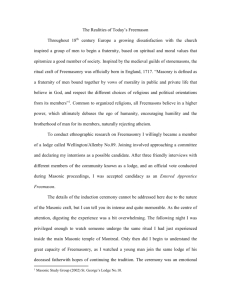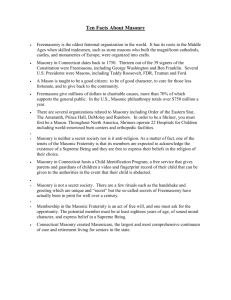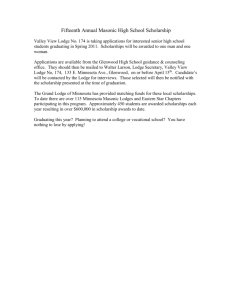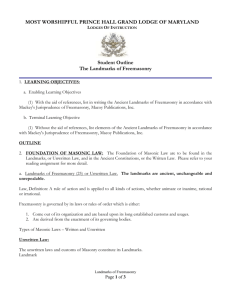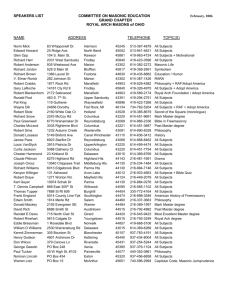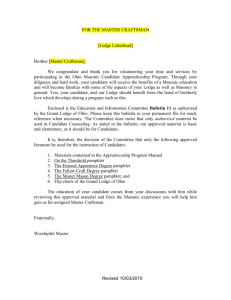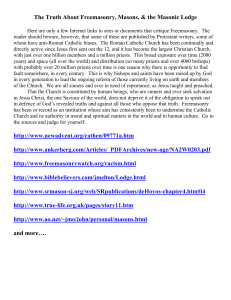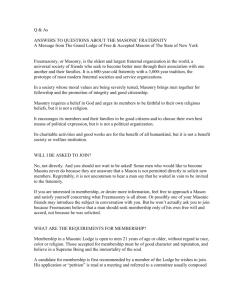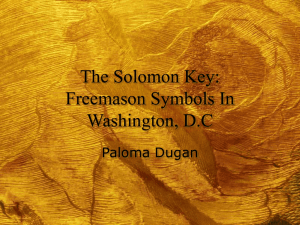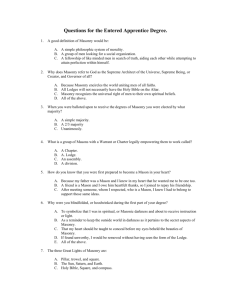books on-line - John L. DeGrazier Masonic Lodge No. 1349
advertisement
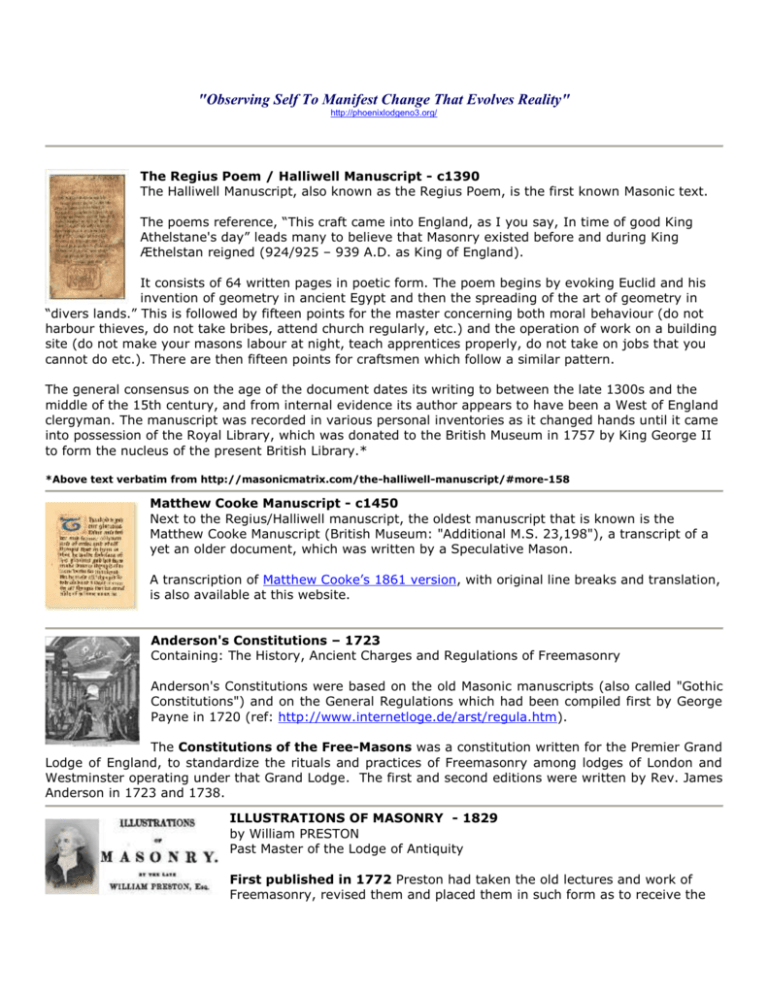
"Observing Self To Manifest Change That Evolves Reality" http://phoenixlodgeno3.org/ The Regius Poem / Halliwell Manuscript - c1390 The Halliwell Manuscript, also known as the Regius Poem, is the first known Masonic text. The poems reference, “This craft came into England, as I you say, In time of good King Athelstane's day” leads many to believe that Masonry existed before and during King Æthelstan reigned (924/925 – 939 A.D. as King of England). It consists of 64 written pages in poetic form. The poem begins by evoking Euclid and his invention of geometry in ancient Egypt and then the spreading of the art of geometry in “divers lands.” This is followed by fifteen points for the master concerning both moral behaviour (do not harbour thieves, do not take bribes, attend church regularly, etc.) and the operation of work on a building site (do not make your masons labour at night, teach apprentices properly, do not take on jobs that you cannot do etc.). There are then fifteen points for craftsmen which follow a similar pattern. The general consensus on the age of the document dates its writing to between the late 1300s and the middle of the 15th century, and from internal evidence its author appears to have been a West of England clergyman. The manuscript was recorded in various personal inventories as it changed hands until it came into possession of the Royal Library, which was donated to the British Museum in 1757 by King George II to form the nucleus of the present British Library.* *Above text verbatim from http://masonicmatrix.com/the-halliwell-manuscript/#more-158 Matthew Cooke Manuscript - c1450 Next to the Regius/Halliwell manuscript, the oldest manuscript that is known is the Matthew Cooke Manuscript (British Museum: "Additional M.S. 23,198"), a transcript of a yet an older document, which was written by a Speculative Mason. A transcription of Matthew Cooke’s 1861 version, with original line breaks and translation, is also available at this website. Anderson's Constitutions – 1723 Containing: The History, Ancient Charges and Regulations of Freemasonry Anderson's Constitutions were based on the old Masonic manuscripts (also called "Gothic Constitutions") and on the General Regulations which had been compiled first by George Payne in 1720 (ref: http://www.internetloge.de/arst/regula.htm). The Constitutions of the Free-Masons was a constitution written for the Premier Grand Lodge of England, to standardize the rituals and practices of Freemasonry among lodges of London and Westminster operating under that Grand Lodge. The first and second editions were written by Rev. James Anderson in 1723 and 1738. ILLUSTRATIONS OF MASONRY - 1829 by William PRESTON Past Master of the Lodge of Antiquity First published in 1772 Preston had taken the old lectures and work of Freemasonry, revised them and placed them in such form as to receive the approval of the leading members of the Craft. The True Masonic Chart, or Hieroglyphic Monitor – 1819 1st edition Believed to be the first hieroglyphic Monitor using visual aids for memory work. Jeremy L. Cross played a significant role in disseminating Bro. Thomas Smith Webb's adaptation of William Preston's work throughout all Masonic jurisdictions in the United States. His True Masonic Chart or Hieroglyphic Monitor is perhaps the best representation of that work, in that it contains elaborate illustrations specifically developed to accompany Webb's lectures. Apart from providing the foundation for the engravings in Masonic monitors in the centuries that followed, Cross invented a number of composite symbols still utilized in Masonic lectures today, perhaps the most significant being the broken column and weeping virgin that appear on the cover. (commentary from Amazon.com). The Ancient Landmarks of Freemasonry – 1858 Every Master Mason is obliged to abide by the Laws, Regulations and Edicts of his Grand Lodge; the By-laws of the particular lodge of which he is a member, and to maintain and support the "Landmarks and Ancient Usages and Customs of the Fraternity." The problem is that The Landmarks (sometimes referred to as The Ancient Landmarks) are the unwritten law of Masonry - the common law - which was apparently so well understood and practiced in early Masonry (prior to formation of the Grand Loge of England in 1717) that it was not thought necessary to record it. In spite of this, throughout our history the "regularity" of a Lodge is judged according to its observance of these Landmarks. The first attempt to codify (or write) the unwritten law of Masonry was achieved by Albert G. Mackey as an article in the October 1858 edition of the American Quarterly Review of Freemasonry and then later in his Encyclopedia of Freemasonry. Mackey's compilation of these Ancient Landmarks is considered by many to be one of the most authoritative sources of information on this topic. Lightfoot's Commentaries - 1934 After an exhaustive comparison of Monitors from other jurisdictions in this country and abroad, and noting missing and inaccurate information in the edition that was in use at the time, R.W. Grand Master W. Steve Cooke made a comprehensive report regarding the importance of issuing a new Monitor. During the Annual Grand Communication of December 5th 1934, R.W. Cooke commended the labors of R.W. Brother Jewel P. Lightfoot in restoring the Monitor and creating, what he called, "the most outstanding, interesting and instructive Masonic book in decades". http://www.tvl1048.org/resources.htm#comm 10,000 Famous Freemasons Volume I - A- D http://www.phoenixmasonry.org/10,000_famous_freemasons/Volume_1_A_to_D.htm Foreword by Harry S. Truman, PGM, Past Master, Missouri Lodge of Research Published by Macoy Publishing & Masonic Supply Co., Inc., Richmond, Virginia Copyright, I957, William R. Denslow
